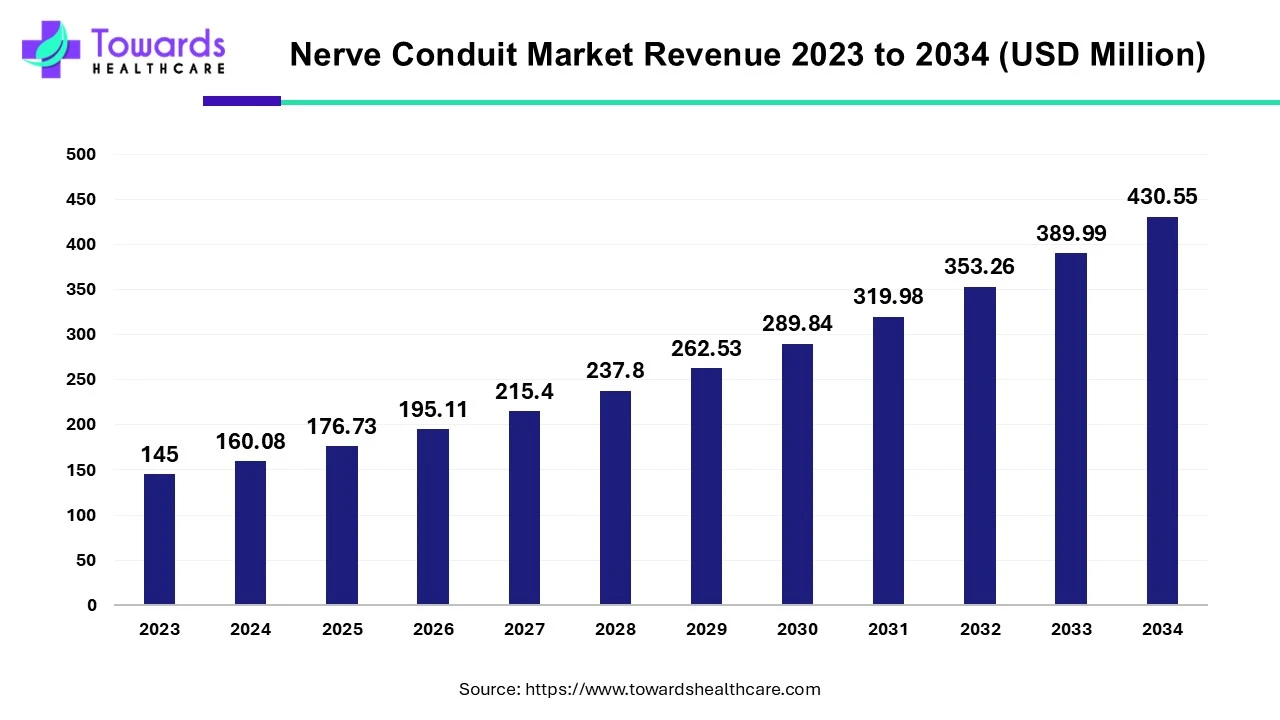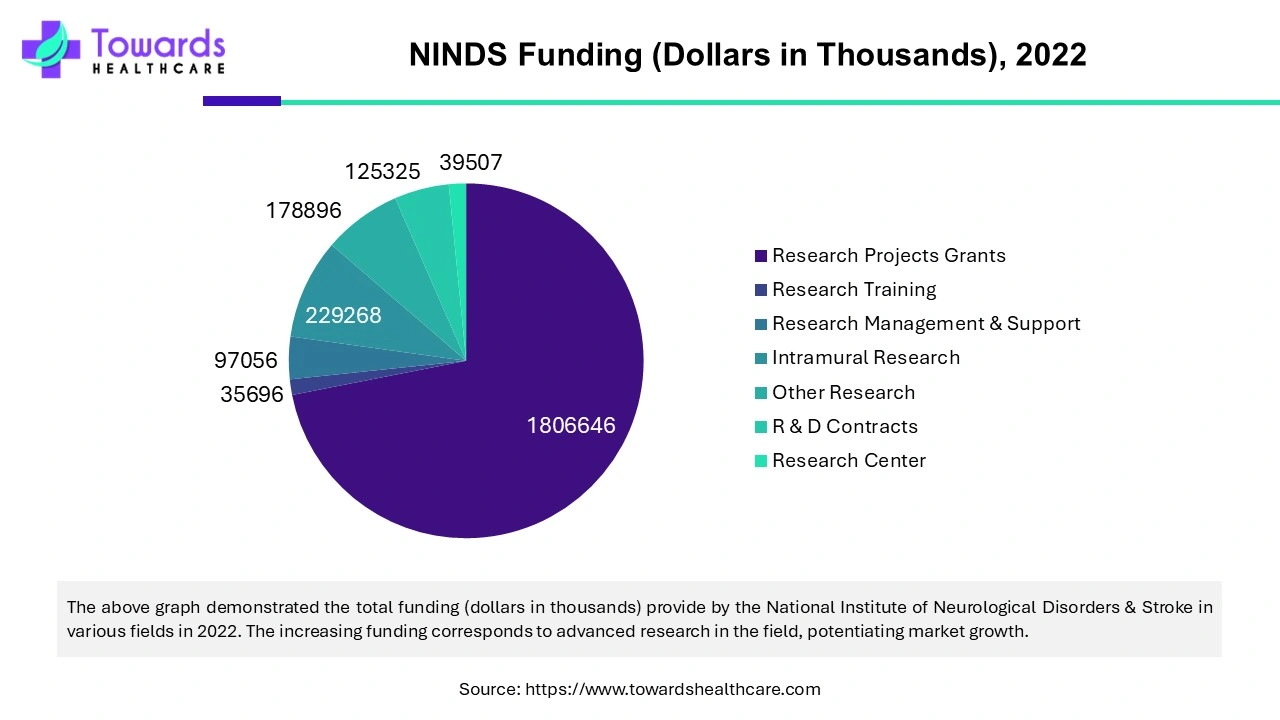January 2025


Principal Consultant

Reviewed By
The nerve conduit market was estimated at US$ 145 million in 2023 and is projected to grow to US$ 430.55 million by 2034, rising at a compound annual growth rate (CAGR) of 10.4% from 2024 to 2034. The rising incidences of peripheral nerve injury, advancements in cell therapy and nanomaterials, and growing research and development drive the market.

A nerve conduit is a minuscule therapeutic biomedical device that acts as an artificial guide for axonal regrowth that aids nerve regeneration. It is used to treat peripheral nerve injury. Nerve conduits enclose, or tubulate, the distal and proximal ends of the severed nerve. Nerve conduits are either hollow tubes, tubes filled with scaffolds containing neurotrophic factors, or those seeded with Schwann cells or stem cells. Silicone and polyglycolide are the most common materials used for constructing a synthetic nerve conduit. Materials used for biological tubes include blood vessels and skeletal vessels. The selection of material is based on several properties, such as biocompatibility, biodegradability, mechanical integrity, and controllability during nerve growth, implantation, and sterilization.
The rising incidences of peripheral nerve injury due to the increasing number of surgeries and trauma cases drive the market. Globally, around 13 to 23 per 100,000 people typically suffer from peripheral nerve injury. Additionally, growing research and development and the advent of advanced technologies boost innovation in nerve conduits.
In March 2022, Integra LifeSciences announced the launch of NeuraGen 3D Nerve Guide Matrix, a resorbable implant for the repair of peripheral nerve discontinuities. The novel product may allow more complete functional recovery following mid-gap nerve repair than hollow nerve conduits alone.
The WHO adopted the “Intersectoral Global Action Plan on Epilepsy and Other Neurological Disorders 2022-2031” at the World Health Assembly 2022 to improve the prevention, early identification, treatment, and rehabilitation of neurological disorders.
The 2023 fourth-quarter revenue of AxoGen, Inc. was around $42.9 million, an 18.7% increase compared to the fourth quarter of 2022. While the full-year revenue of 2023 was $159 million, a 14.7% increase from last year.
The potential of nerve conduits to repair damaged nerve fascinates many researchers and potentiates novel development to improve its capabilities. Many researchers are investigating the use of novel materials or nanomaterials for constructing nerve conduits. The advancements in technology, such as artificial intelligence, can aid in suggesting a combination of materials for preparing nerve conduits. Additionally, 3D printing is an evolving technique used to manufacture nerve conduits. 3D printing can effectively overcome the limitations of traditional methods, such as suitable mechanical properties, permeability, immunogenicity, and biodegradability. 3D printing can stimulate the structure and function of peripheral nerves using various biomaterials and cells. It can also generate customized conduits based on patient requirements. Additionally, neurotrophic factors and biological cues such as bacteria, Schwann cells, and stem cells can be co-printed with biomaterials to promote axon elongation and myelination.
For instance,
The major challenge of the nerve conduit market is the high cost of the nerve conduit. The average cost of many nerve conduits available in the market is more than $1000. This hampers the use of nerve conduits. Additionally, stringent regulatory procedures for approval of nerve conduits. Regulatory approvals are also required for several materials and methods for the preparation of nerve conduits.
North America dominated the nerve conduit market in 2023. Technological advancements, state-of-the-art research & development facilities, increasing investments, favorable government policies, and the presence of key players drive the market. The latest innovations in the nerve conduit foster market growth. The National Institute of Neurological Disorders and Stroke invests in several research projects related to neurological disorders. It invested around $2,513 million in 2022 for research projects and conducts research training and career development programs. The rising incidences of peripheral neural disorders increase the demand for nerve conduits.

Asia-Pacific is anticipated to grow at the fastest rate in the nerve conduit market during the forecast period. The rising incidences of peripheral nerve injury, increasing investments & collaborations, technological advancements, and growing research & development drive the market. The National Key Research and Development Program of China and the Department of Science & Technology of India fund several research projects related to nerve conduits. In China, more than 1 million new peripheral injury cases are reported annually. The rising aging population is the primary cause of peripheral nerve injury incidences in the region. The regeneration of the peripheral nervous system slows down due to aging. The number of people aged 60 years and above in India was around 149 million in 2022 and is projected to double by 2050. Also, the Japanese geriatric population reached 36.25 million as of September 2024, accounting for one-third of the Japanese population.
By type, the synthetic materials segment held a dominant presence in the nerve conduit market in 2023. Synthetic materials used for preparing nerve conduits are either non-biodegradable or biodegradable. The nondegradable materials include silicone, plastic, and PTFE tubes. The biodegradable materials include polyglycolic acid, polylactic acid, glycolide trimethylene carbonate, etc. Synthetic materials can be chosen and modified based on the desired properties. Also, they are readily available and less expensive compared to natural materials.
The natural biomaterials segment is estimated to grow fastest in the nerve conduit market during the forecast period. The demand for natural materials and the ability to prevent resistance by the body augment the segment's growth. Examples of some natural biomaterials include veins, arteries, muscles, and umbilical cord vessels to repair relatively short nerve defects. These materials can then degrade to innocuous products after complete nerve regeneration, preventing other damage.
By application, the hospital segment led the global nerve conduit market in 2023. Nerve conduits are usually placed inside the body during surgeries. Hospitals have favorable infrastructure, specialized equipment, and technical expertise, governing the segment's growth. Also, the increasing number of hospitalizations and favorable capital investment in hospitals promote market growth.
By Type
By Application
By Region
January 2025
December 2024
December 2024
December 2024